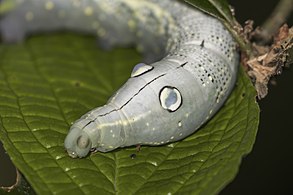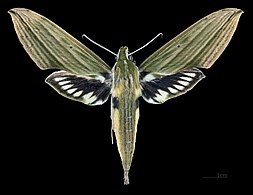
Paonias excaecata, the blinded sphinx, is a moth of the family Sphingidae. The species was first described by James Edward Smith in 1797.

Psilogramma menephron, the privet hawk moth or large brown hawkmoth, is a member of the family Sphingidae. It was described by Pieter Cramer in 1780. It is usually found in Sri Lanka, India, Nepal, central and southern China, Thailand, Vietnam, Indonesia and the Philippines. Psilogramma casuarinae from eastern Australia was long treated as a synonym but is now thought to be a distinct species. The introduced population on Hawaii was first thought to be P. menephron, but is Psilogramma increta.

Xylophanes anubus is a moth of the family Sphingidae first described by Pieter Cramer in 1777.

Xylophanes ceratomioides is a moth of the family Sphingidae. It is known from Mexico, Belize, Costa Rica, French Guiana, Bolivia, Argentina and Venezuela, down into southern Brazil. Rare vagrants have been found up to southern Arizona.

Pergesa is a monotypic moth genus in the family Sphingidae first described by Francis Walker in 1856. Its only species, Pergesa acteus, the green pergesa hawkmoth, was described by Pieter Cramer in 1779.

Acosmeryx anceus is a moth of the family Sphingidae. It was described by Caspar Stoll in 1781, and it is known from India, Myanmar, New Guinea, and Queensland, Australia.

Xylophanes aglaor is a moth of the family Sphingidae first described by Jean Baptiste Boisduval in 1875.

Xylophanes belti is a moth of the family Sphingidae first described by Herbert Druce in 1878.
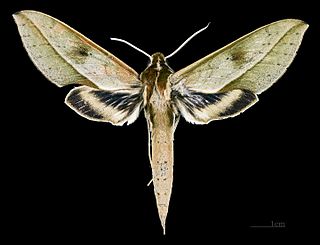
Xylophanes cyrene is a moth of the family Sphingidae first described by Herbert Druce in 1881. It is found in Mexico, Panama, Costa Rica, Guatemala, Belize and south to Oxapampa in Peru.

Xylophanes falco is a moth of the family Sphingidae.

Xylophanes guianensis is a moth of the family Sphingidae.
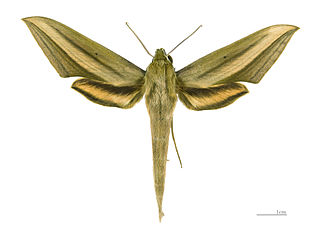
Xylophanes loelia is a moth of the family Sphingidae first described by Herbert Druce in 1878.

Xylophanes media is a moth of the family Sphingidae first described by Walter Rothschild and Karl Jordan in 1903.

Xylophanes mirabilis is a moth of the family Sphingidae. It is known from Colombia.
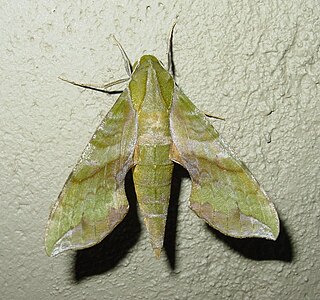
Xylophanes pluto, the Pluto sphinx, is a moth of the family Sphingidae. The species was first described by Johan Christian Fabricius in 1777.

Xylophanes porcus, the porcus sphinx, is a moth of the family Sphingidae. The family was first described by Jacob Hübner in 1823.
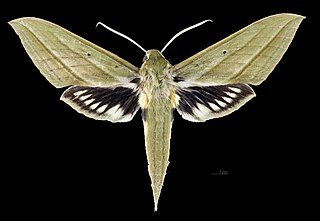
Xylophanes rhodochlora is a moth of the family Sphingidae. It is found in Peru, Bolivia and possibly Colombia.

Xylophanes sarae is a moth of the family Sphingidae.

Xylophanes schausi is a moth of the family Sphingidae first described by Walter Rothschild in 1894.

Xylophanes zurcheri is a moth of the family Sphingidae first described by Herbert Druce in 1894.


